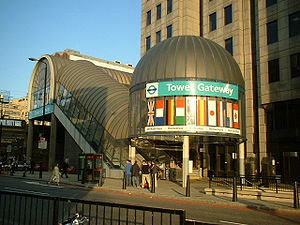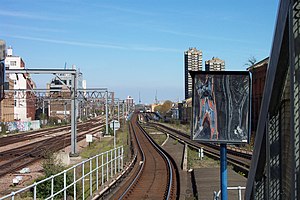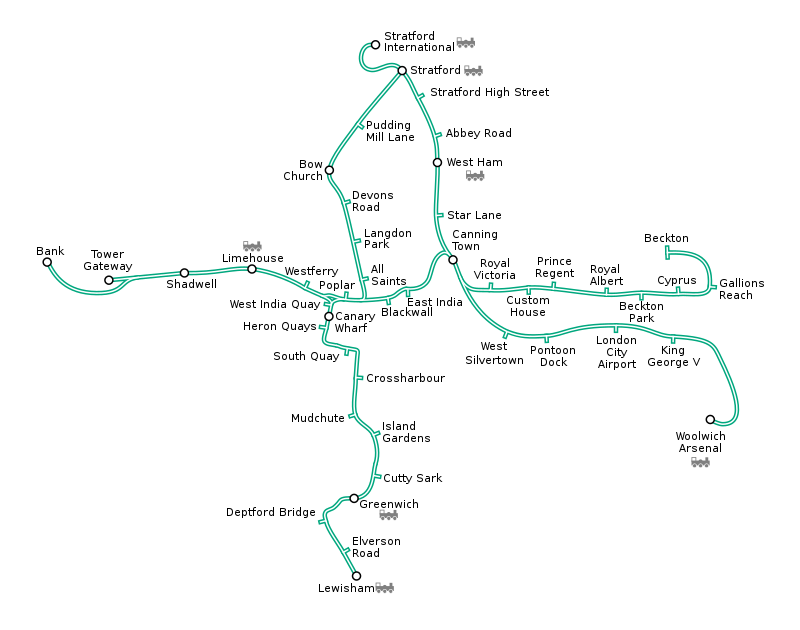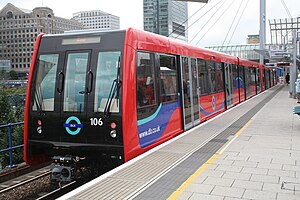Docklands Light Railway
The Docklands Light Railway (DLR) is an automated light metro system opened in 1987 to serve the redeveloped Docklands area of London.[1][2] Primarily serving the Docklands in Middlesex and Essex, it reaches north to Stratford, west to Tower Gateway and Bank in the City of London and east to Beckton and London City Airport with extensions across the River Thames into Kent for Woolwich Arsenal and Lewisham (map).
The system uses minimal staffing on trains and at major interchange stations; the four below-ground stations are staffed to comply with underground station fire and safety requirements. Similar proposals have been made for the Tube.[3]
History
Origins and development
The docks immediately east of Central London began to decline in the early 1960s as cargo became containerised.[4] They had been connected to the national railway network via the London and Blackwall Railway (L&BR), which was closed in 1966 for lack of traffic.[5] The opening of the Tilbury container docks, further east in Essex, finally rendered them redundant, and in 1980 the government gained control of the now-derelict area.
As early as 1972, consideration was given to how to redevelop the moribund Docklands. Travis Morgan & Partners were commissioned by the London Docklands Study Team to consider the issue. They proposed, among other recommendations, that a "minitram" people-mover system capable of carrying up to 20 people in each unit should be constructed to connect the Docklands with the planned Fleet line tube railway terminus at Fenchurch Street railway station. The Greater London Council formed a Docklands Joint Committee with the Boroughs of Greenwich, Lewisham, Newham, Southwark and Tower Hamlets in 1974 to undertake the redevelopment of the area. A light railway system was envisaged, terminating either at Tower Hill tube station or at Fenchurch Street, but both options were seen as too expensive. Nonetheless, in 1976 another report proposed a conventional tube railway for the area and London Transport obtained Parliamentary powers to build a line from Charing Cross railway station to Fenchurch Street, Surrey Docks (now Surrey Quays railway station), the Isle of Dogs, North Greenwich and Custom House to Woolwich Arsenal. This was intended to be the second stage of the Fleet line – which had been renamed the Jubilee line, the first stage of which opened in 1979 from Stanmore to Charing Cross. However, when the Conservative Party came to power in May 1979 under Margaret Thatcher, the plans to extend the Jubilee line were halted and the new government insisted that a lower-cost option should be pursued.[6]
The government created the London Docklands Development Corporation (LDDC) in July 1981 to coordinate the redevelopment of the Docklands. The need to provide a cheap public transport solution led to it commissioning London Transport to evaluate a number of exclusively light rail options. The core of the route ran alongside the Great Eastern line out of London and south along the former London & Blackwall Railway line through the Isle of Dogs. Three terminus options were proposed at the west end, at Tower Hill, Minories and Aldgate East. The Tower Hill option would have required a low-level interchange to be constructed alongside the existing Underground station, but this would have been a very costly venture. The Minories option, a high-level station virtually on the site of the old Minories railway station, was selected and became the current Tower Gateway DLR terminus.[6] Aldgate East would have been perhaps the most ambitious of all of the options, as it originally envisaged a low-level connection with the District line that would have allowed DLR trains to run on Underground tracks to a variety of central London destinations. However, it quickly became apparent that there was no capacity on the existing network for integrating the DLR into the Underground.[7]
Two southern terminus options were put forward, at Cubitt Town (today's Island Gardens station) and Tiller Road, on the west side of Millwall Dock, with two possible routes to reach them. A "western" route would have run from the Westferry station alongside West Ferry Road via Cuba Street, then either terminating at Tiller Road or continuing over Millwall Docks Cut to a terminus at Cubitt Town. The "central" option required the West India Docks to be infilled or bridged and would run down the middle of the peninsula, through what was at the time an area of derelict warehouses.[7] Ultimately this latter option was chosen, though the 1981 London Transport report warned that without extensive development around Canary Wharf the area would be "very isolated with poor traffic prospects" – as indeed it was, for a number of years.[8]
Initial system (1987–1990)
The initial system comprised two routes, from Tower Gateway and Stratford to Island Gardens. Most was elevated on disused railway viaducts or new concrete viaducts, with use of disused surface railway formation between Poplar and Stratford. The trains were fully automated, controlled by computer, and had no driver; a Passenger Service Agent (PSA) on each train, originally referred to as a "Train Captain", was responsible for patrolling the train, checking tickets, making announcements and controlling the doors. PSAs could take control of the train in circumstances including equipment failure and emergencies.[9][10] A total of eleven EMUs supplied by Linke-Hofmann-Busche comprised the first generation of the rolling stock.[11]
The system was lightweight, with stations designed for trains of only a single articulated vehicle. The three branches totalled eight miles, had 15 stations, and were connected by a flat triangular junction near Poplar. Services ran from Tower Gateway to Island Gardens and from Stratford to Island Gardens; the north side of the junction was used only for access to the depot at Poplar.[1][12] The stations were mostly of a common design and constructed from standard components. A common feature was a short half-cylindrical glazed blue canopy. All stations were above ground and were generally unstaffed, although later extension included stations below ground which were required by law to be staffed in case of evacuation.
First stage extensions (1991–1994)
The initial system had a relatively low capacity, but the Docklands area very quickly developed into a major financial centre and employment zone, increasing traffic. In particular Tower Gateway, at the edge of the City of London, attracted criticism for its poor connections, as it did not connect directly with the nearby Tower Hill tube station or Fenchurch Street railway station. The criticism arose partly because the system usage was higher than expected.[13] Plans were developed, before the system opened, to extend it to Bank in the west and Beckton in the east.[14] Stations and trains were extended to two-unit length, and the system was expanded into the heart of the City of London to Bank through a tunnel, which opened in 1991.[15] This extension left Tower Gateway on a stub. The original trains were not suitable for use underground due to a lack of fire-proofing.[11] They were operated for a time on the above-ground sections only, and were later sold.
As the Canary Wharf office complex grew, Canary Wharf DLR station was redeveloped from a small wayside station to a large one with six platforms serving three tracks and a large overall roof, fully integrated into the malls below the office towers.[16]
The east of Docklands needed better transport connections to encourage development, and a fourth branch, towards Beckton, was planned, with several route options available.[17] A route from Poplar via Canning Town and the north side of the Royal Docks complex was chosen, and opened in 1994. Initially it was thought the line was likely to be underutilised, due to the sparse development in the area.[18] As part of this extension, one side of the original flat triangular junction was replaced by a grade-separated junction west of Poplar. Poplar was rebuilt to give cross-platform interchange between the Stratford and Beckton lines, with a new grade-separated junction built east of the station at the divergence of the Stratford and Beckton lines.
Second stage extensions (1996–1999)

Early on, Lewisham Council commissioned a feasibility study into extending the system under the River Thames. This led the council to advocate an extension via Greenwich and Deptford, terminating at Lewisham railway station.[19] The ambitions of the operators were supported by politicians in Parliament, including the future Labour Deputy Prime Minister John Prescott, and Lord Whitty; and by 1996 construction work had begun.[16][20][21]
The Lewisham extension opened on 3 December 1999.[22] It left the Island Gardens route south of the Crossharbour turn-back sidings, and dropped gently to Mudchute, where a street-level station replaced the high-level one on the former London & Blackwall Railway viaduct. The line then entered a tunnel, following the route of the viaduct to a shallow subsurface station at Island Gardens, accessible by stairs or a lift. It crossed under the Thames to Cutty Sark in the centre of Greenwich, and surfaced at Greenwich railway station, with cross-platform interchange between the northbound track and the London-bound main line. The line snaked on a concrete viaduct to Deptford Bridge, before descending to Elverson Road at street level, close to Lewisham town centre, terminating in two platforms between and below the main-line platforms at Lewisham railway station, with buses stopping outside the station. The extension quickly proved profitable.[23]
Third stage extensions and enhancements (2004–2009)
The next developments were aided by a five-year programme of investment for public transport across London that was unveiled by Mayor of London Ken Livingstone on 12 October 2004.[24] On 2 December 2005, an eastward branch along the approximate route of the former Eastern Counties and Thames Junction Railway on the southern side of the Royal Docks complex opened from Canning Town to King George V via London City Airport.[25]
A further extension from King George V to Woolwich Arsenal opened on 10 January 2009, providing interchange with the North Kent main line, close to the planned future stop on the Crossrail line to Abbey Wood via West India and Royal Docks,[1] met by Private Finance Initiative funding.[26] Construction began in June 2005, the same month that the contracts were finalised,[27] and the tunnels were completed on 23 July 2007,[28] and formally opened by Boris Johnson, Mayor of London on 12 January 2009.[29] Following completion, the project was shortlisted for the 2009 Prime Minister's Better Public Building Award.[30]
The original Tower Gateway was closed in mid-2008 for complete reconstruction. The two terminal tracks either side of a narrow island platform were replaced by a single track between two platforms, one for arriving passengers and the other for departing (Spanish solution). It reopened on 2 March 2009.[31][32]
As part of an upgrade to allow three-car trains, strengthening work was necessary at the Delta Junction north of West India Quay.[33] It was decided to include this in a plan for further grade separation to eliminate the conflict between services to Stratford and from Bank. A new timetable was introduced, with improved frequencies at peak hours. The new grade-separated route from Bank to Canary Wharf is used throughout the day, bypassing West India Quay station until mid-evening.[34] Work on this project proceeded concurrently with the three-car upgrade work and the 'flyunder', and the improved timetable came into use on 24 August 2009.[35]
Stratford International to Canning Town extension (2011)
In addition to the three-car station extensions, part of which was funded from the 2012 Olympics budget, a line was opened from Canning Town to Stratford and Stratford International along the former North London Line of the national rail system, with additional stations. It parallels the London Underground Jubilee line for much of its length. A substantial multi-level flying junction was built south of Canning Town to enable trains from Bank/Poplar and Stratford International to operate to either of the eastern termini at Beckton and Woolwich Arsenal. There are through trains between all these points, with different patterns at different times of the day. The extension suffered some delay in opening, being completed in August 2011. It provides a direct link between two of the major Olympics locations: the Stadium and Park at Stratford and the ExCeL adjacent to Custom House on the Beckton line.
Current system
The DLR is 25 miles long, with 45 stations.[36] There are six branches: to Lewisham in the south, Stratford and Stratford International in the north, Beckton and Woolwich Arsenal in the east, and Central London in the west, splitting to Bank and Tower Gateway.[37] Although the layout allows many different routes, the seven following are operated in normal service:[38]
- Bank to Lewisham
- Bank to Woolwich Arsenal
- Stratford to Canary Wharf (extended to Lewisham in the Monday to Friday morning peak)
- Stratford International to Beckton
- Stratford International to Woolwich Arsenal
- Tower Gateway to Beckton
There is capability for an additional shuttle from Canning Town to Prince Regent when exhibitions are in progress at the ExCeL exhibition centre.
At terminal stations trains reverse direction in the platforms except at Bank where there is a reversing headshunt beyond the station. Many peak-hour trains on the Lewisham route from Stratford turn back at Canary Wharf. During service disruption or planned engineering work, trains can also turn back at Crossharbour and Mudchute. Trains serve every station on the route, but before mid-evening trains from Bank to Lewisham do not call at West India Quay because they are routed along the flyunder track to avoid junction conflicts. During long-term works for extension projects, other routes may be operated at weekends, such as Beckton to Lewisham if the Bank branch is closed.
The northern, southern and south-eastern branches terminate at the National Rail stations at Stratford, Stratford International, Lewisham and Woolwich Arsenal. Other interchanges with National Rail are at Limehouse, Greenwich and West Ham, while out of station interchanges for Oyster card holders exist between Shadwell DLR station and London Overground's station of the same name, and between Fenchurch Street and the DLR's western termini Tower Gateway and Bank.[39]
Between Limehouse and Tower Gateway, the DLR runs parallel to the London, Tilbury and Southend Railway.
Stations
Most stations are elevated, with others at street level, in cutting or underground. Access to the platforms is mostly by staircase and lift, with escalators at some stations. From the outset the system has been fully accessible to wheelchairs; much attention was paid to quick and effective accessibility for all passengers.[40] The stations have high platforms matching the floor height of the cars, allowing level access for passengers with wheelchairs or pushchairs.
Most stations are of a modular design dating back to the initial system, extended and improved with two side platforms, each with separate access from the street, and platform canopies, although few examples remain of the original, distinctive rounded roof design. Stations are unstaffed, except the underground stations at station=Bank, Island Gardens, Cutty Sark and Woolwich Arsenal for safety reasons, a few of the busier interchange stations, and City Airport, which has a ticket office for passengers unfamiliar with the system. Canning Town, Custom House and Prince Regent are normally staffed on the platform whenever there is a significant exhibition at the ExCeL exhibition centre.
On 3 July 2007, DLR officially launched[41] an art programme called DLR Art,[42] similar to that on the London Underground, Art on the Underground. Alan Williams was appointed to produce the first temporary commission, called "Sidetrack", which portrays the ordinary and extraordinary sights, often unfamiliar to passengers, on the system and was displayed throughout the network.[43]
Rolling stock
The DLR is operated by 145[44] high-floor bi-directional single-articulated Electric Multiple Units (EMUs). Each car has four doors on each side, and two or three cars make up a train.[1] There are no cabs because normal operations are automated, and a small driver's console is concealed behind a locked panel at each end, from which the PSA can drive the car.[45] Consoles at each door opening allow the PSA to control door closure and make announcements whilst patrolling the train. With the absence of a driver's position, the fully glazed car ends provide a forward and rear view for passengers. The top speed is 60 mph.
Despite having high floors and being automated, the cars are derived from a German light-rail design intended for street running. All cars look similar but there have been several different types, some still in service, others sold to other operators. B2007 units were purchased from Bombardier in 2005 and delivered between 2007 and 2010.[46]
Depots
There are operating and maintenance depots at Poplar, now secondary to the larger site at Beckton, built on the site of the Beckton Gas Works in 1996 and accessed via a spur at Gallions Reach.[47] Rolling stock is kept at both locations, which have maintenance workshops and extensive open-air carriage sidings. The Poplar depot, which is also the operating headquarters of Docklands Light Railway Ltd, KeolisAmey Docklands Ltd and the Emirates Air-Line cable car, houses diesel locomotives used for track maintenance. Poplar depot is alongside the north side of the Stratford line east of the station, and Beckton depot is to the east of the line on a long spur north-east of Gallions Reach.
One of the diesel locos stabled at Poplar is 1979 GEC Traction 0-4-0, one of three built for Shotton Steelworks. Since they were used at the steelworks, one has been scrapped, one has recently been acquired by the Yorkshire Wolds Railway and the third is now at Poplar named "Kevin Keaney". Its original nickname was "Sooty" because of the amount of exhaust this old engine produced.
References
Footnotes
- ↑ 1.0 1.1 1.2 1.3 "Docklands Light Railway Capacity Upgrading, United Kingdom". http://www.railway-technology.com/projects/docklands/. Retrieved 13 June 2014.
- ↑ Cross, David (1 September 1987). "Enthusiasts flock to busy opening day: Docklands Light Railway". The Times (London).
- ↑ Chapman, James (14 January 2011). "Boris Johnson: I'll use driverless Tube trains to break strikes". Daily Mail (London). http://www.dailymail.co.uk/news/article-1347012/Boris-Johnson-Ill-use-driverless-Tube-trains-break-strikes.html.
- ↑ "The closure of the docks: The end of the upstream docks". Barking & Dagenham Council. Archived from the original on 17 September 2008. https://web.archive.org/20080917134945/http://www.bardaglea.org.uk:80/docklands/9-the-end.html. Retrieved 24 June 2009.
- ↑ Christopher, John (30 September 2013). The London & Blackwall Railway. Amberley Publishing Limited. p. 63. ISBN 978-1-4456-2187-6. http://books.google.com/books?id=Wg2oAwAAQBAJ.
- ↑ 6.0 6.1 Pearce, Alan; Hardy, Brian; Stannard, Colin (November 2000). Docklands Light Railway Official Handbook. Harrow Weald: Capital Transport Publishing. p. 4-5. ISBN 185414-223-2.
- ↑ 7.0 7.1 Pearce, Hardy & Stannard, Docklands Light Railway Official Handbook (2000), p. 6
- ↑ Pearce, Hardy & Stannard, Docklands Light Railway Official Handbook (2000), p. 7
- ↑ "Technology: Signalling & Control". Transport for London. http://www.tfl.gov.uk/corporate/modesoftransport/dlr/keyfacts/1546.aspx. Retrieved 29 August 2007.
- ↑ "The Docklands Light Railway, London, UK". BBC – h2g2. http://www.bbc.co.uk/dna/h2g2/A9948757. Retrieved 29 August 2007.
- ↑ 11.0 11.1 McCarthy, Colin; McCarthy, David (2009). Railways of Britain – London North of the Thames. Hersham, Surrey: Ian Allan Publishing. p. 12. ISBN 978-0-7110-3346-7.
- ↑ "Mayor of London – Transport Strategy – DLR". Greater London Authority. c. 2006. Archived from the original on 12 March 2008. https://web.archive.org/20080312115619/http://www.london.gov.uk:80/mayor/transport/dlr.jsp. Retrieved 19 March 2012.
- ↑ "New Games transport link marks 20 years of progress". London 2012 Official Blog. 13 January 2009. Archived from the original on 28 May 2009. https://web.archive.org/20090528013329/http://london2012.com:80/blog/2009/01/13/new-games-transport-link-marks-20-years-of-dlr-progress.php. Retrieved 24 June 2009.
- ↑ "Hansard Written Answers". UK Parliament. 6 May 1987. http://hansard.millbanksystems.com/written_answers/1987/may/06/docklands-light-railway#S6CV0115P0_19870506_CWA_30.
- ↑ "Ben Roskrow reports on Nuttal's extension of the Docklands Light Railway". Construction News. 16 February 1990. http://www.cnplus.co.uk/news/16feb90-uk-ben-roskrow-reports-on-nuttalls-extension-of-the-docklands-light-railway-(1-of-2)/1689334.article. Retrieved 25 June 2009.
- ↑ 16.0 16.1 "DLR history timeline". Transport for London. Archived from the original on 30 September 2007. https://web.archive.org/20070930190323/http://www.tfl.gov.uk/corporate/modesoftransport/dlr/history/2982.aspx. Retrieved 3 September 2007.
- ↑ "Options for the DLR Beckton Extension route". London Docklands Development Corporation. http://www.lddc-history.org.uk/transport/3tran15.jpg. Retrieved 23 February 2008.
- ↑ Widdicombe, Gillian (30 March 1994). "Architecture: A driverless train, a blighted destination". The Independent (London). http://www.independent.co.uk/arts-entertainment/art/news/architecture-a-driverless-train-a-blighted-destination-a-railway-deep-into-londons-docklands-emphasises-the-potential-yet-to-be-realised-in-the-east-says-gillian-widdicombe-1432567.html. Retrieved 24 June 2009.
- ↑ Wolmar, Christian (25 January 1995). "Crucial links hold key to the future: Docklands, a special report". The Independent (London). http://www.independent.co.uk/life-style/crucial-links-hold-key-to-the-future--docklands-a-special-report-1569645.html. Retrieved 24 June 2009.
- ↑ "Prescott backs DLR airport extension". New Civil Engineer. http://www.nce.co.uk/prescott-backs-dlr-airport-extension/844052.article. Retrieved 25 June 2009.
- ↑ M2 Presswire (18 February 1999). "DLR: Take off for airport link". Press release. http://www.highbeam.com/doc/1G1-53908044.html. Retrieved 25 June 2009.
- ↑ De Haan, Judy (29 August 2000). "Getting Back on the Right Track (letter to the editor)". The Bolton News. http://www.theboltonnews.co.uk/news/344110.credit_crunch_shows_signs_of_easing. Retrieved 25 June 2009.
- ↑ Withers, Malcolm (8 March 2001). "DLR helps Mowlem ride high at £25 million". London Evening Standard. http://www.highbeam.com/doc/1G1-75307455.html. Retrieved 25 June 2009.
- ↑ Muir, Hugh (12 October 2004). "Mayor unveils £10bn scheme for capital's transport". The Guardian (London). http://www.guardian.co.uk/uk/2004/oct/12/transport.london. Retrieved 28 June 2009.
- ↑ Hamilton, Fiona; Coates, Sam; Savage, Michael (6 December 2005). "Docklands Light Railway reaches City airport". The Times (London). http://www.timesonline.co.uk/tol/travel/business/article749409.ece. Retrieved 25 June 2009.
- ↑ "New DLR extension wins approval". BBC News. 26 February 2004. http://news.bbc.co.uk/1/hi/england/london/3489298.stm. Retrieved 24 June 2009.
- ↑ "AMEC, RBoS jv finalise contract for DLR extension to Woolwich Arsenal". Forbes (New York). 6 January 2005. http://www.forbes.com/feeds/afx/2005/06/01/afx2068185.html. Retrieved 24 June 2009.
- ↑ Transport for London (23 July 2007). "Tunnel extending Docklands Light Railway to Woolwich completed". Press release. http://pressroom.dlr.co.uk/news/details.asp?id=141. Retrieved 29 June 2008.
- ↑ Transport for London (12 January 2009). "Mayor unveils DLR Woolwich Arsenal station". Press release. http://www.tfl.gov.uk/static/corporate/media/newscentre/archive/10970.html. Retrieved 19 March 2012.
- ↑ "DLR extension award". Construction News. 10 June 2009. http://www.cnplus.co.uk/sectors/transport/dlr-extension-award/5203213.article. Retrieved 24 June 2009.
- ↑ "Tower Gateway Station – Now Open". Transport for London. http://improvements.dlr.co.uk/project_updates/towergateway.asp. Retrieved 21 June 2009.
- ↑ "DLR Terminal suddenly reopens: Taking passengers by surprise". East London Advertiser (Ilford). http://www.eastlondonadvertiser.co.uk/content/towerhamlets/advertiser/news/story.aspx?brand=elaonline&category=news&tBrand=northlondon24&tCategory=newsela&itemid=WeED02%20Mar%202009%2008%3A51%3A29%3A073. Retrieved 21 June 2009.
- ↑ Christopher (2013), p. 68
- ↑ "Docklands Light Railway (DLR) Delta Junction Grade Separation". Transport for London. http://developments.dlr.co.uk/pdf/enhancements/phase2/delta.pdf. Retrieved 21 June 2009.
- ↑ "Docklands Light Railway – West India Quay/Poplar Junction Improvements". Transport for London. http://developments.dlr.co.uk/enhancements/capacity/wiqpoplar.asp. Retrieved 1 August 2009.
- ↑ "About TfL - Culture & heritage - London's transport - a history - Docklands Light Railway (DLR)". Transport for London. http://www.tfl.gov.uk/corporate/about-tfl/culture-and-heritage/londons-transport-a-history/dlr. Retrieved 13 June 2014.
- ↑ "Docklands Light Railway". Official London Guide. http://www.visitlondon.com/travel/getting_around/docklands-light-railway. Retrieved 19 March 2012.
- ↑ "DLR routes" (pdf). Transport for London (TfL). http://www.tfl.gov.uk/cdn/static/cms/documents/dlr-route-map.pdf. Retrieved 13 June 2014.
- ↑ "OSI List". oyster-rail.org.uk. October 2014. http://www.oyster-rail.org.uk/osi-list/. Retrieved 14 April 2015.
- ↑ "DLR was the first fully accessible railway in the UK, making access much easier for everyone". Transport for London. http://www.tfl.gov.uk/gettingaround/transportaccessibility/2986.aspx. Retrieved 4 March 2012.
- ↑ Transport for London (3 July 2007). "Docklands Light Railway draws up public arts strategy". Press release. http://www.tfl.gov.uk/static/corporate/media/newscentre/archive/5426.html. Retrieved 4 March 2012.
- ↑ "The DLR Public Arts Programme". DLR Art. http://www.dlrart.co.uk/. Retrieved 5 August 2010.
- ↑ "Alan Williams – Sidetrack". Docklands Light Railway. http://www.dlrart.co.uk/projects/view.asp?id=8. Retrieved 25 June 2009.
- ↑ "About TfL - What we do - Docklands Light Railway". Transport for London (TfL). http://www.tfl.gov.uk/corporate/about-tfl/what-we-do/docklands-light-railway. Retrieved 13 June 2014.
- ↑ "Unmanned Train: DLR Respond". The Londonist (blog). 2 November 2007. http://londonist.com/2007/11/unmanned_train.php. Retrieved 19 March 2012.
- ↑ Bombardier (4 May 2005). "Bombardier receives a $94 million US order from Docklands Light Railway for automatic Light Rail cars to be used in London, UK". Press release. http://bombardier.com/en/corporate/media-centre/press-releases/details?docID=0901260d8000fc2d. Retrieved 14 July 2009.
- ↑ Christopher (2013), p. 67
Bibliography
- Jolly, Stephen; Bayman, Bob (November 1986). Docklands Light Railway Official Handbook. Harrow Weald: Capital Transport Publishing. ISBN 0-904711-80-3.
- Gonsalves, B.F.; Deacon, R.W.; Pilgrim, D; Pritchard, B.P. (October 1991). Docklands Light Railway and Subsequent Upgrading. 90. Proceedings of the Institution of Civil Engineers. OCLC 24833359.
Outside links
| ("Wikimedia Commons" has material about Docklands Light Railway) |








